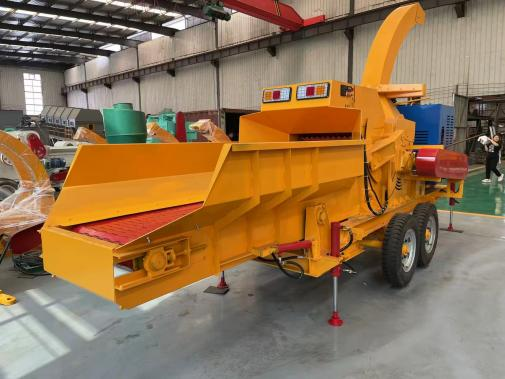Kesen Machinery (Shandong Kesen), a specialist in forestry and garden equipment since 2003, sits at the intersection of two converging market arcs in 2025: steady, demand-driven growth in large forestry machinery and rapid, technology-led transformation in small garden and outdoor power equipment. Drawing on Kesen’s product mix — portable bandsaw sawmills, wood chippers, log splitters and lawncare machines — below is a close, data-informed look at the trends shaping opportunity and risk for both ends of the product spectrum, and practical implications for manufacturers and exporters.


The global forestry-equipment market remains a mid-sized but steady sector, driven by fleet replacement, mechanization in emerging markets, and stricter emissions rules for industrial machines. Recent industry reports put the forestry-equipment market near USD 11 billion in the mid-2020s with low-to-moderate CAGR expectations (around 3–5% in most forecasts). These dynamics favor manufacturers who can offer rugged, reliable machines and strong after-sales support.
At the same time, the lawn & garden / outdoor power equipment market is substantially larger and growing faster — estimates place the global lawn & garden market in the low-to-mid tens of billions (USD 40–50B range) with higher CAGRs (typically 6–7% for the next 5–10 years). Within that market, battery-electrified and cordless tools are the fastest-growing segment. This divergence means small garden tools offer volume and faster innovation cycles, while forestry machinery offers higher per-unit value and longer sales cycles.
For consumer and light-commercial garden tools (cordless trimmers, battery lawn mowers, cordless chainsaws), electrification is the dominant trend — driven by urban noise/emissions restrictions, falling battery costs, and convenience for end users. Market forecasts show the electric cordless segment expanding rapidly, with analysts projecting strong double-digit growth in the cord-less battery category over the decade. That creates opportunities for Kesen to expand battery-ready models or offer electric variants for its best sellers.
For heavy forestry machinery, electrification is happening but more slowly. OEMs are experimenting with hybrid drivetrains, telematics, and electrified auxiliary systems; however, high-power continuous tasks (skidders, large chippers) still often require diesel or hybrid solutions for the foreseeable future. The implication: prioritize battery and cordless development for small-machine lines, while planning gradual hybrid/low-emission upgrades for larger models and emphasizing fuel efficiency and emissions compliance now.
Across both segments, customers are paying for intelligence: IoT telematics, predictive maintenance, and fleet management tools improve uptime and lower lifetime costs. In forestry, telematics and AI route/fleet optimization help contractors increase productivity; in garden equipment, robot mowers and connected consumer tools are gaining traction (recent new product launches target larger yards and pro users). Adding telematics-ready controllers or simple CANbus interfaces to machines increases appeal to distributors and fleet buyers.
Demand composition is shifting: professional contractors in developed markets continue to replace aging fleets, while homeowners and small landscape services increasingly buy battery tools and robotic solutions. This bifurcation means sales channels and marketing must be segmented: B2B sales, financing and service networks for large machines; e-commerce, retail partnerships and warranty/consumable strategies for small tools. Kesen’s existing product line (both heavy and portable machines) positions the company well to sell into both buckets if channel strategies are tailored correctly.
Global supply chains continue to normalize after pandemic disruptions, but component cost pressure (batteries, electronic controls, semiconductors) and shipping volatility remain important variables. Competitive advantage will come from agile manufacturing, reliable QA, and transparent lead times — all areas where Kesen’s in-house R&D and production capability can be emphasized to buyers. In export markets, quick spare-parts availability and clear service policies often win deals over lower-priced but slower competitors.
Prioritize modular electrified variants for best-selling small machines. Design battery-ready platforms for the wood chipper/log splitter lineup where feasible. This aligns with strong cordless tools growth and opens retail channels.
Add telematics-ready options and a service dashboard. Offer a simple telematics kit as an add-on for larger clients and include a subscription-style maintenance package for contractors.
Segment go-to-market: strengthen distributor/after-sales support for heavy equipment; establish e-commerce and retail packaging for consumer products (clear warranty, spare blade/kits).
Showcase emissions & compliance data in quotes. For international buyers, publish fuel-consumption / emissions figures and compliance notes to shorten procurement discussions.
Invest in product marketing that highlights TCO (total cost of ownership). Use data — uptime, consumable costs, and parts availability — to demonstrate value over lifetime, not just purchase price.
2025 is a year of dual opportunity: the forestry equipment market rewards reliability, heavy-duty performance and after-sales strength, while the lawn & garden sector rewards fast innovation, electrification and consumer convenience. For Kesen Machinery, the most pragmatic strategy is to treat these as complementary business lines — continue to fortify core heavy-machine competence and after-sales networks, while rapidly building modular, battery-friendly versions of top small-machine SKUs and telematics-enabled options. That combination protects current revenue streams and positions Kesen to capture outsized growth in the electrified consumer market.
 Hot News
Hot News2024-12-26
2024-12-18
2024-10-11
2024-09-18
2024-09-09
2024-07-25